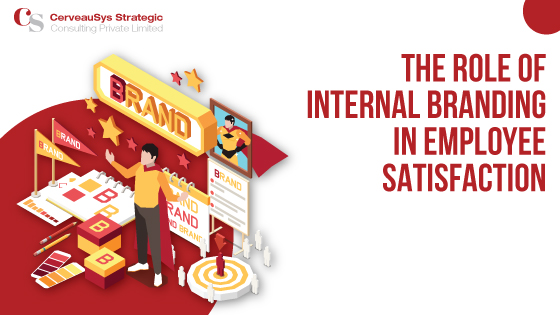Cultivating Engagement: The Role of Internal Branding in Employee Satisfaction
In today’s cutthroat business environment, employee engagement is no longer just a nice-to-have but a must-have. Engaged employees are more productive, satisfied, and likely to stick around. Plus, they can be powerful brand ambassadors, spreading the word about your company’s culture and mission. At CerveauSys Strategic, the Best Performance Management Consulting Firm in Pune, we believe that one key to fostering employee engagement is internal branding – making sure your employees feel connected to and proud of the company they work for. Let’s explore the importance and role of internal branding in employee satisfaction and unlock strategies to create a highly engaged workforce.
Key to Cultivating Engagement: Understanding Internal Branding
Internal branding is the strategic process of aligning an organization’s external brand promise with the internal employee experience. It involves creating a consistent and compelling narrative that resonates with both the organization’s customers and its employees. By effectively communicating the brand’s values, mission, and goals, internal branding helps employees understand their role in delivering on the brand promise and fosters a sense of ownership and pride in their work.
The Impact of Internal Branding on Employee Satisfaction
- Increased Alignment and Purpose
When employees understand the organization’s brand, values, and objectives, they are better equipped to align their personal goals and actions with the company’s vision. This sense of purpose and connection to the organization’s mission can lead to higher levels of job satisfaction and commitment. - Enhanced Job Satisfaction
Effective internal branding can create a positive and engaging work environment, where employees feel valued, respected, and appreciated. This can lead to improved job satisfaction, reduced turnover, and a more motivated workforce. - Improved Employee Advocacy
Employees who are passionate about the brand and feel a strong connection to the organization are more likely to become brand advocates, promoting the company’s products, services, and reputation to both internal and external stakeholders. - Stronger Employer Brand
A well-executed internal branding strategy can enhance an organization’s employer brand, making it more attractive to potential employees and contributing to the company’s ability to attract and retain top talent.
Key Strategies for Effective Internal Branding
1. Clearly Define the Brand Promise
Establishing a clear and compelling brand promise that resonates with both customers and employees is crucial. Ensure that the brand’s values, mission, and goals are well-articulated and communicated throughout the organization. This helps employees understand the organization’s identity, purpose, and aspirations, enabling them to align their actions and mindset accordingly.
2. Align Internal Processes and Systems
Aligning the organization’s internal processes, HR practices, and systems (such as performance management, rewards and recognition, training and development) with the brand promise and employee value proposition is essential. This integration ensures that the employee experience is consistent with the external brand promise, fostering a sense of cohesion and authenticity.
3. Foster Effective Communication
Implementing effective communication channels and strategies to engage employees, share updates, and gather feedback is key. Encourage open dialogue and foster a culture of transparency, where employees feel empowered to voice their ideas, concerns, and feedback. This open communication helps build trust, enhance collaboration, and drive continuous improvement.
4. Empower Employees
Empowering employees to take ownership of the brand and become active participants in the organization’s success is a powerful strategy. Provide them with the necessary resources, training, and autonomy to deliver on the brand promise. This fosters a sense of ownership, responsibility, and pride, leading to greater engagement and commitment.
5. Recognize and Reward
Developing a robust recognition and reward system that acknowledges and celebrates employees who consistently demonstrate the organization’s brand values and contribute to the overall success of the company is essential. This reinforces the desired behaviors and motivates employees to align their actions with the brand.
6. Lead by Example
Ensuring that the organization’s leaders and management team model the desired brand behaviours and values sets the tone for the rest of the workforce. When leaders embody the brand promise, they inspire and empower employees to follow suit, creating a cohesive and authentic brand culture.
The Path Forward to Internal Branding
By implementing effective internal branding strategies, organizations can drive increased alignment, purpose, and job satisfaction among their employees. Additionally, these efforts can lead to improved employee advocacy, stronger employer branding, and a more motivated and loyal workforce – all of which contribute to the overall success and growth of the organization.
If you’re looking to enhance employee satisfaction and engagement through the power of internal branding, CerveauSys Strategic is the ideal partner for your organization. As a leading Performance Management Consulting Firm in Pune, we specialize in developing and implementing customized solutions that drive strategic performance improvements. Our team of experts will work closely with you to assess your current internal branding efforts, identify areas for improvement, and craft a tailored approach that aligns with your business objectives and employee needs.
By partnering with CerveauSys Strategic, you can unlock the full potential of your workforce, cultivate a thriving organizational culture, and position your company for long-term success. Contact us today to learn more about how we can help you achieve your employee satisfaction and engagement goals through the power of internal branding.



